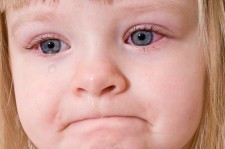Pinkeye (Conjunctivitis)
What is pinkeye?
Pinkeye (conjunctivitis) is an infection that affects the covering of the eyeball and the inside of the eyelid. While it is usually caused by a virus, it can also be caused by bacteria.
What are the symptoms?
- Children with pinkeye will complain of a scratchy feeling in their eyes.
- There may be lots of tearing.
- The whites of the eyes are pink or red. The eyelid may also be slightly swollen.
- Pus or discharge from the eyes can make the eyelids sticky during sleep, and can collect in the corners of the eyes when awake.
How does pinkeye spread?
Pinkeye spreads easily by:
- Direct contact: when a child with pinkeye touches the discharge from their eye and then touches another child.
- Indirect contact: when an object that is contaminated with the virus, such as a tissue, is touched or touches another person’s eyes.
- Droplet: when pinkeye is caused by a common cold, droplets from a sneeze or cough can also spread it.
How is pinkeye treated?
The treatment may involve antibiotic eye drops or ointment and will depend on the type of pinkeye.
Purulent pinkeye, with a pink or red eyeball, white or yellow discharge, sticky or red eyelids and eye discomfort, is usually caused by bacteria. It is treated with antibiotics (eye drops or ointment), which stop the illness from spreading to others.
Non-purulent pinkeye, where the eyeball is pink or red but the discharge is clear or watery, has only mild or no discomfort. It is usually caused by a virus or other irritant (such as an allergy or exposure to a chemical like the chlorine in a pool). An antibiotic drop will not work for this type of pinkeye.
When should I see the doctor?
Talk to your doctor:
- If your baby has purulent eye discharge and is less than 3 months old.
- If you think your child has pinkeye. It is not easy to know if a bacteria or a virus has caused the infection. Your doctor will know if your child needs an antibiotic or other treatment.
- If your child seems unwell and has a fever, rash or eye pain, or if the pinkeye seems to keep coming back. Some more serious illnesses may look like pink eye at first.
How can I prevent the spread of pinkeye?
- Wipe tears or discharge from your child’s eye from the inside out and in one direction only. Use a clean part of the cloth each time.
- Wash your hands and your child’s hands very carefully after touching or wiping your child’s eyes.
- Don’t share towels or washcloths because they could spread the illness.
- If your child has viral pinkeye, they can return to child care once they have seen a doctor. If your child has bacterial pinkeye and is taking antibiotics, they should stay home from child care or school until they’ve had the antibiotics for 24 hours.
Reviewed by the following CPS committees
- Public Education Advisory Committee
Last updated: November 2019

